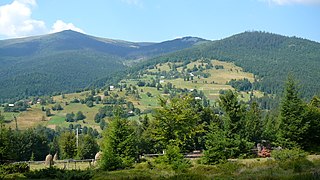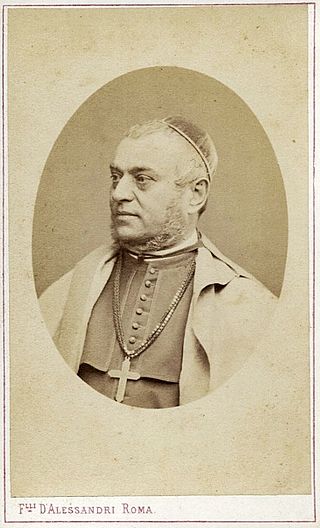
Austria-Hungary, often referred to as the Austro-Hungarian Empire, the Dual Monarchy, or Austria, was a constitutional monarchy and great power in Central Europe between 1867 and 1918. It was formed with the Austro-Hungarian Compromise of 1867 in the aftermath of the Austro-Prussian War and was dissolved shortly after its defeat in the First World War.

Hungary is a landlocked country in Central Europe. Spanning 93,030 square kilometres (35,920 sq mi) of the Carpathian Basin, it is bordered by Slovakia to the north, Ukraine to the northeast, Romania to the east and southeast, Serbia to the south, Croatia and Slovenia to the southwest, and Austria to the west. Hungary has a population of 9.7 million, mostly ethnic Hungarians and a significant Romani minority. Hungarian, the official language, is the world's most widely spoken Uralic language and among the few non-Indo-European languages widely spoken in Europe. Budapest is the country's capital and largest city; other major urban areas include Debrecen, Szeged, Miskolc, Pécs, and Győr.

Hungarian is a Uralic language spoken in Hungary and parts of several neighbouring countries that used to belong to it. It is the official language of Hungary and one of the 24 official languages of the European Union. Outside Hungary, it is also spoken by Hungarian communities in southern Slovakia, western Ukraine (Subcarpathia), central and western Romania (Transylvania), northern Serbia (Vojvodina), northern Croatia, northeastern Slovenia (Prekmurje), and eastern Austria.

Transylvania is a historical and cultural region in Central-Eastern Europe, encompassing central Romania. To the east and south its natural border is the Carpathian Mountains and to the west the Apuseni Mountains. Broader definitions of Transylvania also include the western and northwestern Romanian regions of Crișana and Maramureș, and occasionally Banat. Historical Transylvania also includes small parts of neighbouring Western Moldavia and even a small part of south-western neighbouring Bukovina to its north east.

Budapest is the capital and most populous city of Hungary. It is the ninth-largest city in the European Union by population within city limits and the second-largest city on the Danube river; the city has an estimated population of 1,752,286 over a land area of about 525 square kilometres. Budapest, which is both a city and county, forms the centre of the Budapest metropolitan area, which has an area of 7,626 square kilometres and a population of 3,303,786; it is a primate city, constituting 33% of the population of Hungary.

Franz Joseph I or Francis Joseph I was Emperor of Austria, King of Hungary, and the other states of the Habsburg monarchy from 2 December 1848 until his death on 21 November 1916. In the early part of his reign, his realms and territories were referred to as the Austrian Empire, but were reconstituted as the dual monarchy of the Austro-Hungarian Empire in 1867. From 1 May 1850 to 24 August 1866, he was also president of the German Confederation.

Pest is a county (vármegye) in central Hungary. It covers an area of 6,393.14 square kilometres (2,468.41 sq mi), and has a population of 1,213,090 (2009). It surrounds the national capital Budapest and the majority of the county's population live in the suburbs of Budapest. It shares borders with Slovakia and the Hungarian counties Nógrád, Heves, Jász-Nagykun-Szolnok, Bács-Kiskun, Fejér, and Komárom-Esztergom. The River Danube flows through the county. The capital of Pest County is Budapest, but it is planned to completely separate the capital from the county at least until 2020, as it loses catch-up aids from the European Union because of the high development of Budapest.
Vasad is a town in the Anand District of Gujarat, India. It is located on the bank of the Mahi. It was formerly known as Vasudhanagari, and is situated on the north bank of the Mahi and serves as a gateway to the Charotar.

Sardar Vallabhbhai Patel Institute of Technology, Vasad, or SVIT, is a private technical institute located on the bank of the Mahi River, Gujarat, India. It offers undergraduate and graduate-level technical education. It also organizes many events like PRAKARSH(A National-level Technical Symposium), VISION(Inter-Departmental Tech-Fest), SPANDAN(Gujarat Technological University Fest) and AVISHKAR(A Project Exhibition).
Svit or SVIT may refer to:

Hungarians, also known as Magyars, are a nation and ethnic group native to Hungary and historical Hungarian lands who share a common culture, history, ancestry and language. The Hungarian language belongs to the Uralic language family. There are an estimated 15 million ethnic Hungarians and their descendants worldwide, of whom 9.6 million live in today's Hungary. About 2 million Hungarians live in areas that were part of the Kingdom of Hungary before the Treaty of Trianon in 1920 and are now parts of Hungary's seven neighbouring countries, Slovakia, Ukraine, Romania, Serbia, Croatia, Slovenia, and Austria. Significant groups of people with Hungarian ancestry live in various other parts of the world, most of them in the United States, Canada, Germany, France, the United Kingdom, Chile, Brazil, Australia, and Argentina.

Curtuișeni is a commune in Bihor County, Crișana, Romania with a population of 3,780 people. It is composed of two villages, Curtuișeni and Vășad (Érvasad).

Ioan Vancea was an Austro-Hungarian ethnic Romanian bishop of the Greek-Catholic Church. Born to noble parents in Văşad, Bihor County, he was ordained a priest in 1845 following studies in Oradea and Vienna. After the death of Ioan Alexi, he was consecrated Bishop of Gherla in 1865. Three years later, following the death of Alexandru Sterca-Șuluțiu, he was elected Archbishop of Făgăraş and Alba Iulia, enthroned at Blaj in 1869. He advocated the rights of Romanians in Transylvania and contested the authorities' policy of Magyarization. Vancea died in office in 1892.

The Ahmedabad–Mumbai main line or the Mumbai–Ahmedabad main line is a railway route on the Western Railway section of Indian Railways. It is one of the busiest railway routes of the Indian Railways and is fully electrified. The Western line of the Mumbai Suburban Railway operates on the southern part of this route.
Mirza Dovlet oglu Valiyev was an Azerbaijani Red Army senior sergeant and a Hero of the Soviet Union. Valiyev was posthumously awarded the title for his actions in the Budapest Offensive. Commanding a 45mm anti-tank gun, he reportedly destroyed a number of German tanks after his crew was killed, and was himself killed. On 24 March 1945 Valiyev was posthumously awarded the title of Hero of the Soviet Union.

Monor is a district in central-eastern part of Pest County. Monor is also the name of the town where the district seat is found. The district is located in the Central Hungary Statistical Region.
Vasad Junction railway station is a railway station on the Western Railway network in the state of Gujarat, India. Vasad Junction railway station is 15 km far away from Anand railway station. Passenger, MEMU and few Express trains halt at Vasad Junction railway station.
Kathana railway station is a railway station on the Western Railway network in the state of Gujarat, India. Passenger trains start from Kathana railway station. Kathana railway station is connected by rail to Vasad Junction and Vadodara Junction.
Kathana is a large village in Anand district in the Indian state of Gujarat.
The Vasad–Kathana line belongs to Vadodara division of Western Railway zone in Gujarat State.

















